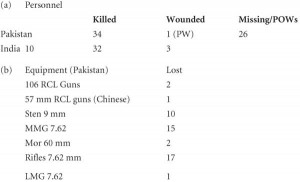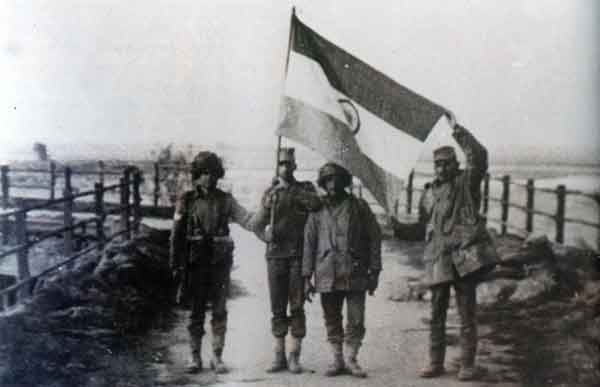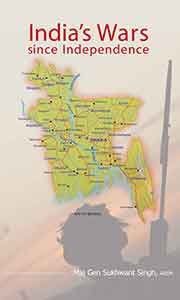Dera Baba Nanak (DBN) is a small town about 30 miles north of Amritsar and south of the Ravi. Near it are two strategically important enclaves, north and south of the Ravi, belonging to India and Pakistan respectively. The Indian enclave is called Kasowal and the Pakistani Jassar or DBN. The Pakistani enclave includes the Ravi road-rail bridge, over which the Pakistani communications network in the Passur-Narowal area can be integrated easily with ours in Punjab.
On the other hand, the Kasowal enclave provides a sizable bridgehead across the Ravi from where operations can be developed against the defences of Jassar and Narowal fortress. DBN enclave can be outflanked from Kasowal with ease. Thus both sides have readymade bridgeheads in each other’s territory which can be exploited both offensively and defensively, depending upon the requirements of overall strategic planning.
The Indian planners have always been sensitive to the DBN fridge as roads from DBN lead to major towns of Punjab like Gurdaspur, Batala, Beas and Amritsar and militarily outflank the defences of Amritsar and the Pathankot base. In the 1965 war, much embarrassment was prevented when the Pakistanis demolished a span of the bridge in a hurry although the Indians had not been able to eliminate the DBN enclave. With use of the bridge impaired by this premature action of the Pakistani commander, India was able to ward off a flank threat with a minimal containing force.
The Indian planners have always been sensitive to the DBN fridge as roads from DBN lead to major towns of Punjab…
Starting immediately south of the bridge, the DBN enclave runs about 1,000 yards east to west, forming a narrow strip varying from 1,000 to 2,498 metres in depth. Apart from manning the BOPs all along the international border, Pakistan planned to hold the crucial part of the enclave from the bridge to the narrower end, where there was a structure popularly known as Colonel’s Hut, in strength and the remaining portion very lightly. Towards this end, a network of skilfully sited concrete pillboxes had been constructed on various bunds in the area and interconnected by bricklined communication trenches. This consisted of our bunds radiating from the eastern end of the bridge and called, in clockwise sequence, the depth, rail, road and river bunds. The Dhussi bund, essentially for flood protection, branches off from the rail bund and runs eastward south of the Ravi up to the Ranger post at Mardana. It has an important feature, 7r, guarding the gauntlet at the narrowest point of the segment and covering the Dhussi bund approach to Colonel’s Hut.
To the south of this bund are about seven ring bunds in the form of small mounds covered with scrub which were built earlier to provide immediate defence in the interim period while RCC emplacements were under construction. Although no longer in use, they could be utilized if Pakistan decided to reinforce the enclave.
The whole area was marshy and covered with a thick growth of sarkanda (elephant grass). Immediately south of the bridge was a dense grove of shisham and kikar trees obscuring observation of the area from the Indian side. The assessment of Pakistani strength and disposition in the enclave was assessed from the deployability the bund feature offered rather than from physical confirmation by other sources.
Pakistan was known to have three Ranger posts within the bridgehead. At the outbreak of hostilities, Pakistan was expected to deploy about two companies (one regular and one Ranger) augmented by MMG and RCL guns of reconnaissance and support elements, with the backing of an infantry battalion less one company north of the bridge. Their two embankments astride the bridge known as the western end and Dry Tree Bund, as also the old railway quarters at Jassar, had been converted into formidable defences completely covered from view by trees.
Pakistan was known to have three Ranger posts within the bridgehead.
About 2130 hours on the night of 3/4 December, Pakistan launched a surprise attack on the Kasowal enclave with a combat group of tanks and infantry preceded by intense artillery bombardment. The enclave was vacated by 0430 hours on 4 December by our troops as part of the overall plan. Fazal Muqeem describes this action thus: “On the night of 3 December 71, Pakistan 8 Infantry Division cleared Dharam (Indian name Kasowal) enclave without any difficulty as the attack seemed to have come as a complete surprise to the defenders.” Brig Gauri Shanker, in command of 86 Infantry Brigade Group responsible for operations in the area, was ordered to eliminate the Pakistani enclave at DBN by first light on 6 December.
In addition to his brigade group units, he was allotted one armoured regiment and an independent artillery brigade consisting of about one field regiment, two medium regiments and one light regiment for the task. His plan broadly envisaged crossing the Ravi west of Metia by 71 Armoured Regiment less one squadron, and 10 Dogra to capture the bund complex immediately south of the bridge as the first phase of the attack commencing at last light on 5 December. This involved 10 Dogra’s recrossing the river near the bridge.
In the second phase, 1/9 Gorkha Rifles was to capture the Dhussi bund, from T Junction up to Colonel’s Hut by O430 hours on 6 December, and 17 Rajput, so far holding the firm base, was to clear the outposts between the base and the bund by first light the same day. Operations preceding the main attack included securing the 7r feature by the brigade commando company as well as securing and preparing the first crossing on the river by about a company of 17 Rajput. To aid the progress of the main attack, a subsidiary operation to secure the Jassar railway quarters north of the river was also planned.
The plan was put into action at 1700 hours on 5 December. After securing the Metla enclave, 71 Armoured Regiment less one squadron and 10 Dogra group proceeded towards crossing No 1, but progress was slow because of a holdup on the ramp by an overturned vehicle and bogging down of a few tanks which tried to circumvent this obstacle. Movement was further impeded by a combination of tall sarkanda grass, heavy mist and the marshy surface of the ground traversed. On reaching the crossing, the column found the banks about ten to 13 feet high with an abrupt drop, thus barring tanks from negotiating them.
The column was then ordered to follow the south bank of the Ravi and make a crossing wherever feasible. Inching forward, it reached 7r, already secured by the brigade commando company (grouped as such from battalion commando platoons), about midnight. Night and the attendant hours of darkness were flitting away and the column was nowhere near its objective.
As tanks of the squadron located south of T Junction were proceeding to the lane, they were engaged by our own tanks operating along the Dhussi bund as a result of faulty identification, but the mistake was rectified after a few casualties.
The plan was perforce modified to accelerate progress. Making use of the lodgment already achieved in the 7r area, 1/9 Gorkha Rifles, the second phase troops, were ordered to attack along the Dhussi bund, using 7r as the forming-up place, instead of from the direction of T Junction.
Working along the bund from bunker to bunker, the battalion captured its objectives by first light on 6 December. The armoured regiment, now unable to cross the river, also moved along the bund in support of 1/9 Gorkha Rifles. The presence of tanks wore down the resistance considerably. Meanwhile, 10 Dogra followed the south bank and reached their FUP about 0315 hours the same day undetected and launched their attack soon after.
The enemy was taken completely by surprise in the rear. The defending toops manned and fired their weapons excessively in panic, but in the wrong direction. 10 Dogra secured the entire eastern end about 0430 hours and 17 Rajput cleared theKhokarke and Sandhuwan Ranger posts by 0700 hours, thus completing the elimination of the DBN enclave. The independent artillery brigade supported the operation throughout, with intimate, timely and abundant artillery fire. So effective was the brigade’s counter-battery programme that there was no interference by the enemy artillery.
On completing phase 2, it was planned to open the axis of maintenance along the main road towards the bridge by clearing vehicle lanes through the enemy minefield by trawling. Since trawls could not be fitted in time because of enemy interference, the lanes were handbreached. As tanks of the squadron located south of T Junction were proceeding to the lane, they were engaged by our own tanks operating along the Dhussi bund as a result of faulty identification, but the mistake was rectified after a few casualties.
The casualties to troops and loss of equipment in this elimination operation were:
 Since the routes of enemy withdrawal between the bridge and the 7r feature were effectively blocked by 10 Dogra’s manoeuvre from the rear, it is apparent that the Pakistani commander had not given the enclave the same degree of tactical importance as our planners did. From the number of casualities in personnel, it would appear that Pakistan held the enclave with no more than a weak company consisting mostly of paramilitary troops, and on interrogation of prisoners it transpired that on the night of the attack the Pakistani company commander had gone to the north bank leaving his force leaderless.
Since the routes of enemy withdrawal between the bridge and the 7r feature were effectively blocked by 10 Dogra’s manoeuvre from the rear, it is apparent that the Pakistani commander had not given the enclave the same degree of tactical importance as our planners did. From the number of casualities in personnel, it would appear that Pakistan held the enclave with no more than a weak company consisting mostly of paramilitary troops, and on interrogation of prisoners it transpired that on the night of the attack the Pakistani company commander had gone to the north bank leaving his force leaderless.
This attitude of mind to change and the ability of the troops to conform to the continuing changes appear to be the key to success in this battle.
On conclusion of the operation, I had an opportunity to inspect the weapons and fortifications captured. The defences consisted of 18 MMG concrete pillboxes, eight RCL emplacements, six three-inch mortar pits and communication trenches some 640 metres long. The network was skilfully sited, well concealed and complexed into a well-coordinated defensive position as a fortress. The extensive minefields were contrived to cover mainly the frontal approaches. These fortifications were not fully manned as evidence turned up by the assaulting Indian troops revealed. For example, the two 106-mm RCL guns were captured in the garage of Colonel’s Hut and none of the RCL’s emplacements were manned. In fact, some of them had been walled up for use as living quarters. Nor were the mortar pits occupied. Of the 15 MMGs captured, only two had tripods which could be used for fixed-line fire support at night.
On the face of it, this operation seems to have been one of “crushing a peanut with a sledge hammer,” but in view of the strategic importance of the enclave the Indian planners could not take a chance. Although it is open to argument whether the Kasowal enclave, by virtue of its location in relation to the DBN enclave, deserved greater attention for its defence, the elimination of the DBN enclave may be termed a well-conceived and well-executed operation.
The conduct of the operation speaks highly for the flexibility the commander displayed in changing the plan to suit the situations posed by the imponderables encountered in its execution rather than sticking rigidly to the original plan. This attitude of mind to change and the ability of the troops to conform to the continuing changes appear to be the key to success in this battle. Credit must go to Gauri Shanker, a signals officer who applied the inherent flexibility of his parent arm subtly. I wonder whether an infantry officer in his position would have stood up to this test.
The method of assault adopted by 1/9 Gorkha Rifles, working along the bund from pillbox to pillbox, making extensive use of pole charges, Molotov cocktails and hand grenades, paid big dividends. The unexpectcd direction of the attack by 10 Dogra carried the day. In the event, this unit’s movement along the southern bank of the Ravi proved more profitable as wading close to the bridge from the north bank without tank support would have invited retaliation from the Pakistani battalion in the general area north of the bridge. The intimate integration of all arms, infantry, armour and artillery promoted success. It was a neat operation which points to the need for unorthodoxy in tackling a tactical problem in war.







True description of the complete operation. I was IO of 1/9GR also manning B1 net during the attack on 5/6 night.
Thank you for the excellent write-up, sir.
My uncle fought in this battle. He passed away at a very young age in 1972, and I have always wanted to visit the place that he had written to me about. This is the first time I came across a reference to the battle of Dera Baba Nanak, and there is a hope that you can point me to a person or organization who can tell me more about it, so I can visit the place. Please let me know directly at my email address.
Every Indian salute Indian army